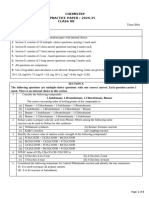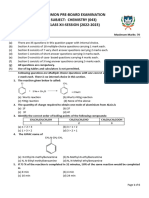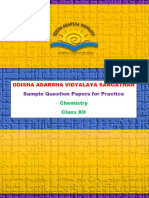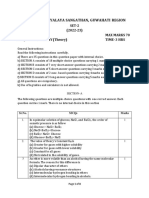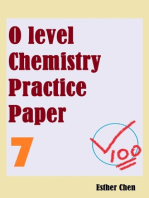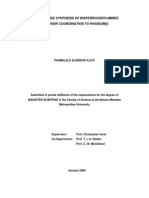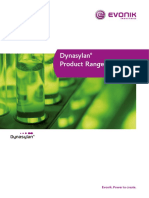Unsolved Practice Paper 3
Uploaded by
sylvia.jayaUnsolved Practice Paper 3
Uploaded by
sylvia.jayaUNSOLVED PRACTICE PAPER 3
CHEMISTRY – 12
Time : 3 hrs Max. Marks : 70
General Instructions
1. There are 35 questions in this question paper with internal choice.
2. Section A consists of 18 multiple-choice questions carrying 1 mark each.
3. Section B consists of 7 very short answer questions carrying 2 marks each.
JI
4. Section C consists of 5 short answer questions carrying 3 marks each.
5. Section D consists of 2 case-based questions carrying 4 marks each.
6. Section E consists of 3 long answer questions carrying 5 marks each.
7. All questions are compulsory.
8. Use of log tables and calculators is not allowed.
LA SECTION-A
The following questions are multiple-choice questions with one correct answer. Each question
carries- I mark. There is no internal choice in this section. .
1. To get carboxylic acids directly from alcohol, which of the following oxidising agents is used?
(a) Alkaline KMnO4 (b) Aqueous KMnO4
(c) Acidified KMnO4 (d) Anhydrous CrO3
2. Which of the following statements about SN2 mechanisms is incorrect?
(a) The transition state is stable.
A
(b) The complete mechanism takes place in a single step.
(c) The rate of the reaction depends on the concentration of both reactants.
(d) There is an inversion of configuration.
3. Zinc and mercury do not show variable valency like d-block elements because
B
(a) they are soft
(b) their d-shells are complete
(c) they have only two electrons in the outermost subshell
(d) their d-shells are incomplete
4. A cathode and an anode are the most common components of an electrochemical cell. Which
of the following claims about the cathode is correct?
(a) Oxidation occurs at the cathode
(b) Electrons move into the cathode
CLASSES BY ANKUR SIR 7983744732
(c) Usually denoted by a negative sign
(d) Is usually made up of insulating material
5. The potential energy diagram for the reaction R → P is given below:
∆H° of the reaction corresponds to the energy
(a) a (b) b (c) c (d) a + b
JI
6. What effect does temperature have on the half-life of a first-order reaction?
(a) It increases (b) It decreases
(c) It remains the same (d) Both increases as well as decrease
7. Arrange the following in the decreasing order of their boiling points:
A: 3-methylbutan-2-ol; B: 2-methylbutan-2-ol; C: Pentan-1-ol
(a) A > B > C (b) C > B > A (c) A > C > B (d) C > A > B
LA
8. The core atom of which of the following biologically significant coordination molecules is
magnesium?
(a) Vitamin B12 (b) Haemoglobin
(c) Chlorophyll (d) Carboxypeptidase-A
9. For which of the following is the Hinsberg approach used?
(a) Preparation of primary amines (b) Separation of amine mixtures
(c) Preparation of tertiary amines (d) Preparation of secondary amines
10. Which of the following compounds is formed when benzyl alcohol is oxidised with KMnO4 ?
A
(a) O2 and H2O (b) Benzoic acid (c) Benzaldehyde (d) Benzophenone
11. Which test can tell the difference between p-chloroaniline and anilinium hydrochloride?
(a) Sandmeyer reaction (b) Carbylamine test
(c) AgNO3 (d) NaHCO3
12. What does the given graph represent about the nature of reaction? Which of the following
B
expressions are in favour of the graph?
CLASSES BY ANKUR SIR 7983744732
(a) ∆ [A]/At = Δ [B]/∆t (b) -Δ[B]/Δt = Δ[A]/Δt
(c) - Δ [A] / Δ t = Δ [B] / Δ t (d) None of these
13. For the square planar complex | Mabcd | where M is the central atom and a, b, c, d are
monodentate ligands, the number of possible geometrical isomers are
(a) 1 (b) 2 (c) 3 (d) 4
14. Propanone can be prepared from ethyne by
(a) passing a mixture of ethyne and steam over a catalyst, magnesium at 420°C
(b) passing a mixture of ethyne and ethanol over a catalyst zinc chromite
(c) boiling ethyne with water in the presence of HgSO4 and H2SO4
(d) treating ethyne with iodine and NaOH
Direction (Q, Nos. 15-18) In the following questions as Assertion (A) is followed by a
JI
corresponding Reason (R) use the following keys to choose the appropriate answer.
(a) Both A and R are true and R is the correct explanation of A.
(b) Both A and R are true but R is not the correct explanation of A.
(c) A is true but R is false.
(d) A is false but R is true.
15. Assertion (A) With HI, anisole gives iodobenzene and methyl alcohol.
LA
Reason (R) Iodide ion combines with smaller group to avoid steric hindrance.
16. Assertion (A) Vitamin D cannot be stored in our body.
Reason (R) Vitamin D is fat soluble vitamin and is excreted out of the body with urine.
17. Assertion (A) Transition metals are good catalysts.
Reason (R) V2O5 or Pt is used in the preparation of H2SO4 by contact process.
18. Assertion (A) Acetanilide is less basic than aniline.
Reason (R) Acetanilide is formed by reaction of aniline with acetic anhydride.
A
SECTION-B
This section contains 7 questions with internal choice in two questions. The following questions
are very short answer type and carry 2 marks each.
19. A first order reaction has a rate constant of 0.0051 min-1. If we begin with 0.10 M
concentration of the reactant, what concentration of reactant will remain in solution after 3
B
hours?
20. What happens when D-glucose is treated with
(a) hydroxylamine? (b) acetic anhydride?
Or
Account for the following.
(a) Change occurs in the nature of egg protein on boiling.
(b) Vitamin A and vitamin C essential for us.
21. Give reasons for the following.
CLASSES BY ANKUR SIR 7983744732
(a) Ethyl iodide undergoes SN2 reaction faster than ethyl bromide.
(b) (±)-2-butanol is optically inactive.
Or
(a) Name the reactant and reagent used to form chloropropane. Write the chemical reaction
involved.
(b) Out of and which one is more reactive towards nucleophilic
substitution reaction and why?
22. When a coordination compound COCl3.6NH3 is mixed with AgNO3, 3 moles of AgCl are
precipitated per mole of the compound. Write Structural formula of the complex and IUPAC
name of the complex.
23. In the button cells widely used in watches and other devices the following reaction takes
JI
place:
Zn(s) + Ag2O(s) + H2O(l) → Zn2+ (aq) + 2 Ag(s) + 2OH-(aq)
Determine ∆rG° and E° for the reaction.
24. A reaction is of first order in reactant A and of second order in reactant B. How is the rate of
LA
this reaction affected when
(a) the concentration of B alone is increased to three times?
(b) the concentrations of A as well as B are doubled?
25. Benzaldehyde can be obtained from benzal chloride. Write reactions for obtaining benzal
chloride and then benzaldehyde from it.
SECTION-C
This section contains 5 questions with internal choice in one questions. The following questions
A
are short answer type and carry 3 marks each.
26. Write the equations for the following reaction.
(a) 2-bromo-2-methylpropane is treated with alcoholic KOH.
(b) Aniline is treated with benzoyl chloride in presence of aq. NaOH.
(c) Phenol is treated with chloroform followed by treatment with dilute HCl.
B
27. Using valence bond theory, explain the following in relation to the [Co(C2O4)3]3-.
(a) Type of hybridisation
(b) Magnetic moment value
(c) Type of complex-inner, outer orbital complex
28. Answer the following questions.
(a) Explain why on addition of 1 mole of NaCl to 1 litre of water, the boiling point of water
increases, while addition of 1 mole of methyl alcohol to one litre of water decreases its boiling
point. (1)
CLASSES BY ANKUR SIR 7983744732
(b) 18 g of glucose, C6H12O6, is dissolved in 1 kg of water in a saucepan. At what temperature
will water boil at 1.013 bar? Kb for water is 0.52 K kg mol-1. (2)
29. Give reasons for any 3 of the following observations.
(a) NH2 group of aniline acetylated before carrying out nitration.
(b) MeNH2 stronger base than MeOH.
(c) Acetylation of —NH2 group of aniline reduce its activating effect.
(d) Aniline is soluble in aqueous HCl.
30. (a) Identify the major product when chlorobenzene undergoes Fittig reaction. Write the
reagents which are used to carry out the reaction. (2)
(b) Allyl chloride is hydrolysed more readily than n-propyl chloride. Why? (1)
Or
JI
(a) Predict the major product formed when HCI is added to isobutylene. Write the reaction
involved. (1)
(b) 7er∈ butylbromide reacts with aq. NaOH by SN1 mechanism while n-butylbromide reacts by
SN2 mechanism. Why? (2)
SECTION-D
The following questions are case-based questions. Each question has an internal choice and
LA
carries 4 (1+1+2) marks each. Read the passage carefully and answer the questions that follow.
31. Amines constitute one of the most important class of organic compounds. In nature they
occur among vitamins, proteins, alkaloids and hormones. Synthetic examples includes drugs,
polymers and dyestuffs. Biologically active compounds such as adrenaline and ephedrine, both
containing secondary amino group are used to increase the blood pressure.
Amines are the derivatives of ammonia obtained by the replacement of one, two or three
hydrogen atoms by alkyl/aryl groups. Like ammonia, nitrogen atom of amines is trivalent and
carries an unshared pair of electrons. Amines are classified as primary secondary and tertiary
amine, depending upon the number of hydrogen atoms in ammonia molecule which get
replaced by alkyl (B) or aryl (Ar) groups.
A
Amines can be prepared by the reduction of nitro compounds, by the Hofmann-bromamide
degradation, by Gabriel phthalimide synthesis etc.
Amines constitute one of the most important class of organic compounds.
Amines are alkyl or aryl derivatives of ammonia formed by replacement of one or more
hydrogen atoms. Alkyl derivatives are called aliphatic amines and aryl derivatives are known as
aromatic amines. Both aliphatic and aromatic primary amines can be prepared by the reduction
B
of nitro compounds catalytically with H2 in the presence of active metal in acidic medium.
The presence of aromatic amines can be identified by performing dye test. Aniline is the
simplest example of aromatic amine. It undergoes electrophilic substitution reactions in which —
NH2 group strongly activates the aromatic ring through delocalisation of lone pair of electrons of
N-atom. Aniline undergoes electrophilic substitution reactions. Ortho and para-positions to the
—NH2 group become centres of high electron density. Thus, —NH2 group is ortho and para-
directing powerful activating group.
Answer the following questions.
(a) What is the best reagent to convert nitrile to primary amine?
CLASSES BY ANKUR SIR 7983744732
(b) How will you convert ethyl iodide to ethyl amine and name all the compound involve in the
various steps?
(c) Geometry of amine is (a) tetrahedral (b) square planar (d) pyramidal. How can you conclude
this?
Or
How can the following conversion can be accomplished. Also give the name of all the
compound involve in the steps.
32. Shipra investigated the rate of reaction of calcium carbonate with dilute nitric acid. She
measured the change in mass of a mixture of calcium carbonate and nitric acid over a period of
JI
time. As carbon dioxide escapes, the mixture loses mass. The graph below shows the results
obtained when 3.0 g lump of calcium carbonate was added to an excess of 1.0 mol/dm3 nitric
acid.
LA
Answer the following on the basis of given experiment.
(a) Had the reaction between calcium carbonate and nitric acid finished after 20 min? Justify
your answer.
(b) What will be the other products of the reactions between calcium carbonate and dilute nitric
acid?
A
(c) Why it is difficult to investigate the rate of reaction in this experiment using powdered calcium
carbonate instead of a lump?
Or
The experiment was repeated using 3.0 g lump of calcium carbonate but an excess of 2.0
mol/dm3 nitric acid.
B
Draw on the graph above, the curve you would expect. Label the curve X.
SECTION-E
The following questions are long answer type and carry 5 marks each. Two questions have an
internal choice.
33. (a) What is the relationship between Gibbs free energy of the cell reaction in a galvanic cell
and the emf of the cell? When will the maximum work be obtained from a galvanic cell? (2)
(b) Aqueous copper sulphate solution and aqueous silver nitrate solution are electrolysed by 1
CLASSES BY ANKUR SIR 7983744732
ampere current for 10 minutes in separate electrolytic cells. Will the mass of copper and silver
deposited on the cathode be same or different? Explain your answer. (1)
(c) How will the pH of brine (aq. NaCl solution) be affected when it is electrolysed? (2)
Or
(a) Solutions of two electrolytes ‘A’ and 'B' are diluted. The λm of ‘B’ increases 1.5 times while
that of A increases 25 times. Which of the two is a strong electrolyte? Justify your answer. (2)
(b) Consider a cell given below : Cu | Cu2+ + || CP | Cl2, Pt (1)
Write the reactions that occur at anode and cathode.
(c) What happens if salt-bridge is removed? Also explain the condition at which cell stop
functioning. (2)
34. Compound ‘A! was prepared by oxidation of compound ‘B’ with alkaline KMnO4. Compound
‘A’ on reduction with lithium aluminium hydride gets converted back to compound ‘B’. When
JI
compound 'A' is heated with compound ‘B’ in the presence of H2SO4 it produces fruity smell of
compound ‘C’.
(a) Identify the compounds A, B, and C. (2)
(b) Write above reactions. (1)
(c) Write reaction of A with NaOH. (1)
(d) Write reaction of A with Cl2 in presence of red phosphorus. (1)
LA Or
An aromatic compound ‘A’ (molecular formula = C8H8O) gives positive 2, 4-DNP test. It gives a
yellow precipitate of compound ‘B' on treatment with iodine and sodium hydroxide solution.
Compound 'A' does not give Tollen’s or Fehling’s test. On drastic oxidation with potassium
permanganate it forms a carboxylic acid ‘C’ (molecular formulaC7H6O2), which is also formed
along with the yellow compound in the above reaction.
(a) Identify A, B and C.
(b) Write all the chemical equations involved.
(c) .Write one method of preparation of C.
A
(d) What happens when C reacts with ammonia?
(e) Will boiling point of C will be higher than A? Why?
35. Answer the following.
(a) Why E° value for Mn and Zn are more negative than expected?
(b) Transition elements show high melting points. Why?
B
(c) Although fluorine is more electronegative than oxygen, but the ability of oxygen to stabilise
higher oxidation states exceeds that of fluorine. Why?
(d) Ionisation enthalpies of Ce. Pr and Nd are higher than Th, Pa and U. Why?
(e) The halides of transition elements become more covalent with increasing oxidation state of
the metal. Why?
CLASSES BY ANKUR SIR 7983744732
PCB ALL IN ONE #3.0( EKTA)
JI
LA 2024 NEW
A
ISC AND ICSE 1.0#
B
CLASSES BY ANKUR SIR 7983744732
You might also like
- PRACTISE PAPER 2025, CLASS XII, CHEMISTRYNo ratings yetPRACTISE PAPER 2025, CLASS XII, CHEMISTRY8 pages
- Kendriya Vidyalaya Sanghthan, Ahmedabad Region SAMPLE PAPER (2022-23) Chemistry Theory (043) MM:70 Time: 3 HoursNo ratings yetKendriya Vidyalaya Sanghthan, Ahmedabad Region SAMPLE PAPER (2022-23) Chemistry Theory (043) MM:70 Time: 3 Hours8 pages
- XII Chemistry Sample Question Paper - FinalNo ratings yetXII Chemistry Sample Question Paper - Final65 pages
- Kendriya Vidyalaya Chemistry Sample Qp-2023-1No ratings yetKendriya Vidyalaya Chemistry Sample Qp-2023-1207 pages
- Corrosion Inhibitors For Refinery OperationsNo ratings yetCorrosion Inhibitors For Refinery Operations15 pages
- Waste Thesaurus SEPA Guidance For Coding Waste June 2015No ratings yetWaste Thesaurus SEPA Guidance For Coding Waste June 201542 pages
- Group 6 - Lab 6 - Preparation of Organic CompoundsNo ratings yetGroup 6 - Lab 6 - Preparation of Organic Compounds5 pages
- Solvent-Free Synthesis of BisferrocenyliminesNo ratings yetSolvent-Free Synthesis of Bisferrocenylimines135 pages
- Next Generation HEUR Technology CoatingsTech March2014No ratings yetNext Generation HEUR Technology CoatingsTech March20149 pages
- Class 12 Chemistry Competency-based Question Bank With Answer Key & Structured Explanation Ch- 9 AMINESNo ratings yetClass 12 Chemistry Competency-based Question Bank With Answer Key & Structured Explanation Ch- 9 AMINES77 pages
- 18287-JEE Main Organic Compounds Containing Nitrogen Revision Notes - Free PDF DownloadNo ratings yet18287-JEE Main Organic Compounds Containing Nitrogen Revision Notes - Free PDF Download14 pages
- Control of Nitrosamine Impurities in Human Drugs PDFNo ratings yetControl of Nitrosamine Impurities in Human Drugs PDF24 pages
- Module 10 Lab: Identification of Organic CompoundsNo ratings yetModule 10 Lab: Identification of Organic Compounds5 pages
- Benzo-And Pyrido - 1,4-Oxazepin-5-Ones and - T Hiones: Synthesis and Structure-Activity Relationships of A New Series of HI AntihistaminesNo ratings yetBenzo-And Pyrido - 1,4-Oxazepin-5-Ones and - T Hiones: Synthesis and Structure-Activity Relationships of A New Series of HI Antihistamines22 pages
- Xiameter® Brand Products For Fabric ConditioningNo ratings yetXiameter® Brand Products For Fabric Conditioning4 pages
- Kendriya Vidyalaya Sanghthan, Ahmedabad Region SAMPLE PAPER (2022-23) Chemistry Theory (043) MM:70 Time: 3 HoursKendriya Vidyalaya Sanghthan, Ahmedabad Region SAMPLE PAPER (2022-23) Chemistry Theory (043) MM:70 Time: 3 Hours
- Practice Makes Perfect in Chemistry: Oxidation-ReductionFrom EverandPractice Makes Perfect in Chemistry: Oxidation-Reduction
- Waste Thesaurus SEPA Guidance For Coding Waste June 2015Waste Thesaurus SEPA Guidance For Coding Waste June 2015
- Group 6 - Lab 6 - Preparation of Organic CompoundsGroup 6 - Lab 6 - Preparation of Organic Compounds
- Next Generation HEUR Technology CoatingsTech March2014Next Generation HEUR Technology CoatingsTech March2014
- Class 12 Chemistry Competency-based Question Bank With Answer Key & Structured Explanation Ch- 9 AMINESClass 12 Chemistry Competency-based Question Bank With Answer Key & Structured Explanation Ch- 9 AMINES
- 18287-JEE Main Organic Compounds Containing Nitrogen Revision Notes - Free PDF Download18287-JEE Main Organic Compounds Containing Nitrogen Revision Notes - Free PDF Download
- Control of Nitrosamine Impurities in Human Drugs PDFControl of Nitrosamine Impurities in Human Drugs PDF
- Module 10 Lab: Identification of Organic CompoundsModule 10 Lab: Identification of Organic Compounds
- Benzo-And Pyrido - 1,4-Oxazepin-5-Ones and - T Hiones: Synthesis and Structure-Activity Relationships of A New Series of HI AntihistaminesBenzo-And Pyrido - 1,4-Oxazepin-5-Ones and - T Hiones: Synthesis and Structure-Activity Relationships of A New Series of HI Antihistamines








